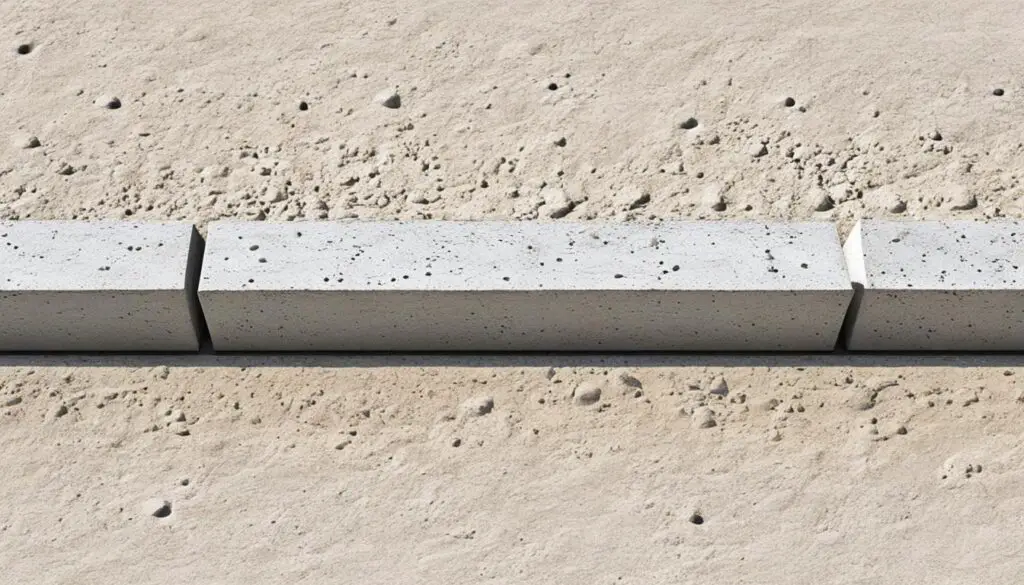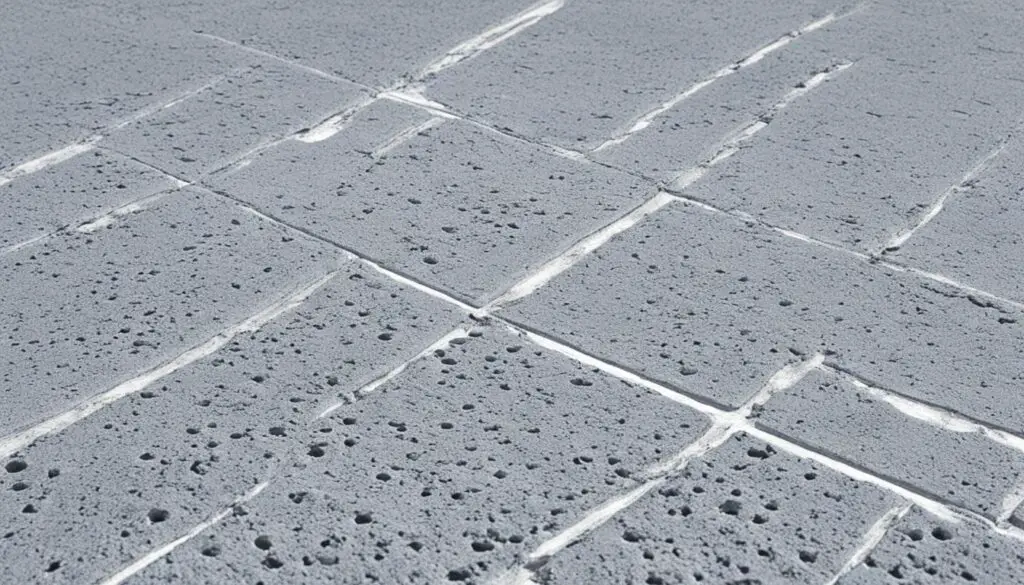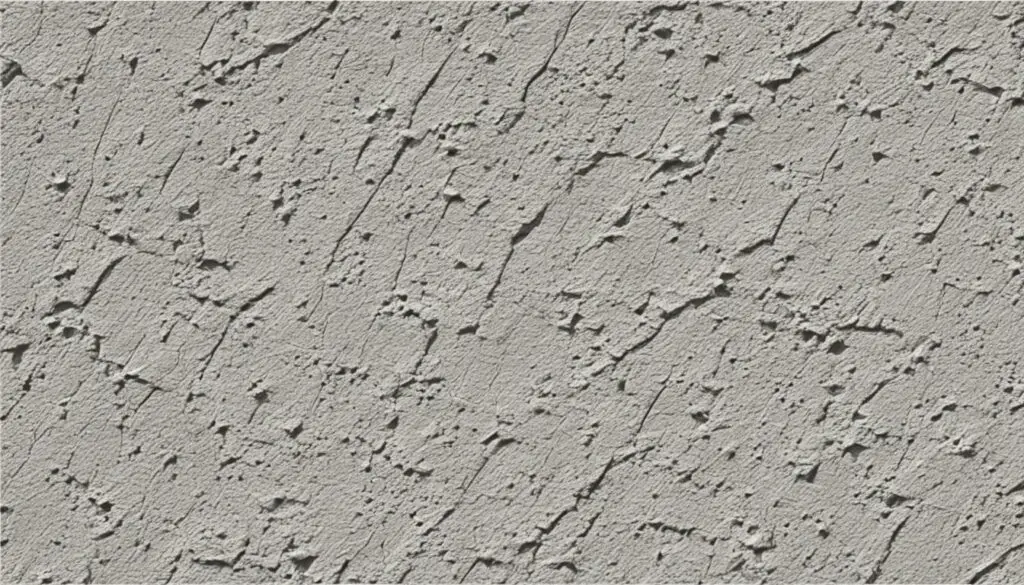Have you ever wondered why some concrete structures remain intact while others develop cracks and damage over time? The secret lies in the concrete joints strategically placed during construction. But what exactly are these joints, and why are they crucial for the stability and longevity of concrete?
In this article, I will provide a comprehensive overview of concrete joints in construction. We will explore the different types and their uses, including expansion joints, contraction joints, isolation joints, and decorative concrete joints. Understanding the purpose and importance of these joints is crucial for ensuring the structural integrity and aesthetics of concrete structures. So, let’s dive in and unravel the mysteries of concrete joints!

Key Takeaways:
- Concrete joints are intentional separations or gaps created during construction to accommodate the natural movement and behavior of concrete.
- There are various types of concrete joints, including expansion joints, contraction joints, isolation joints, and decorative concrete joints.
- Expansion joints allow the concrete to expand and contract without causing cracks due to temperature changes and environmental factors.
- Contraction joints control where cracks occur as the concrete shrinks during the drying and curing process.
- Isolation joints prevent the transfer of loads, vibrations, or movements between different sections of concrete, reducing the risk of damage.
What is a Concrete Joint?
Before delving into the specific types of concrete joints, it is essential to understand what a concrete joint is. Concrete joints are intentional separations or gaps created during construction to accommodate the natural movement and behavior of concrete.
These joints are strategically placed to prevent cracking, displacement, or other forms of damage that can occur due to shrinkage, expansion, or contraction of the concrete material. Concrete joints are crucial for maintaining the structural integrity and longevity of concrete structures.
Concrete joints, also known as construction joints, play a vital role in ensuring the durability and stability of various construction projects. By understanding the different types of construction joints and their uses, builders, and contractors can effectively manage and mitigate potential challenges associated with concrete movement.
Let’s explore the types of construction joints that are commonly used in concrete projects:
- Keyed Joints
- Dowelled Joints
- Bonded Joints
- Butt Joints
Each type of construction joint serves a specific purpose and is implemented based on the requirements of the project. By using the appropriate joint type, builders can ensure the structural integrity and functionality of the concrete.
Now that we have a basic understanding of concrete joints, let’s explore each type in more detail to better grasp their significance in construction.
A well-designed and properly executed concrete joint is essential for the long-term performance of concrete structures. Understanding the purpose and characteristics of different joint types helps ensure the longevity and functionality of concrete projects.
Concrete Construction Joints: Types and Uses
Concrete construction joints play a crucial role in various construction projects, as they allow for the seamless integration of different sections of concrete. These joints are created when concrete is poured at different times or in separate sections, ensuring stability and continuity in the structure. Let’s explore the different types of concrete construction joints and their specific uses:
1. Keyed Joints:
Keyed joints are formed by creating interlocking grooves or protrusions at the joint interface of the concrete sections. This type of joint provides mechanical bonding between the two sections, enhancing the overall strength and preventing horizontal displacement.
2. Dowelled Joints:
Dowelled joints involve the insertion of steel bars or dowels into one section of the concrete, which then fit into corresponding holes in the adjoining section. This type of joint provides both vertical and horizontal load transfer, ensuring structural integrity and reducing the risk of differential settlement or movement.
3. Bonded Joints:
Bonded joints involve the application of bonding agents or adhesives between the two concrete sections. These agents create a strong chemical bond, enhancing the load transfer ability and preventing the ingress of moisture or debris. Bonded joints are commonly used in vertical or overhead construction, such as walls or beams.
4. Butt Joints:
Butt joints are formed when two concrete sections are placed adjacent to each other without any special treatment or connection. While this type of joint lacks mechanical bonding or load transfer, it is often used in certain applications where movement within the joint is not expected or significant reinforcement is present.
Understanding the different types of concrete construction joints and their respective uses is essential for ensuring the stability, durability, and overall quality of concrete structures. By employing the appropriate jointing techniques, construction professionals can mitigate the risks associated with differential movement, cracking, and structural failures.

Expansion Joints in Concrete
Expansion joints are an essential element in concrete construction. These joints are specifically designed to accommodate the natural expansion and contraction of concrete caused by temperature changes, moisture variations, and environmental factors. By allowing the concrete to move without restriction, expansion joints prevent the development of stress and cracks that could compromise the integrity of the structure.
The purpose of expansion joints in concrete is to provide a controlled space for the concrete to expand and contract. This is particularly important in areas with significant temperature fluctuations, as concrete expands when heated and contracts when cooled. Without expansion joints, the resulting stress from thermal expansion and contraction can lead to cracking and structural damage.
When incorporating expansion joints into a concrete structure, careful consideration should be given to their placement and spacing. The location of expansion joints depends on several factors, including the size and dimensions of the concrete pour, the surrounding conditions, and the expected thermal movements. Properly positioned expansion joints ensure that the concrete can freely expand and contract while maintaining its overall stability and durability.
Factors to consider when installing expansion joints:
- Climate and temperature variations
- Concrete thickness and composition
- Type of structure and its intended use
- Movement and load-bearing requirements
By incorporating expansion joints into concrete construction, contractors and engineers can mitigate the potential risks associated with thermal expansion and contraction. This proactive approach helps to maintain the longevity and functionality of the concrete structure while ensuring its aesthetic appeal. The strategic placement of expansion joints coupled with regular maintenance can significantly extend the lifespan of concrete buildings, highways, bridges, and other infrastructure.

With proper design and implementation, expansion joints in concrete serve as a crucial element in preserving the structural integrity of various construction projects. Whether it’s a small residential driveway or a massive commercial complex, the proactive inclusion of expansion joints ensures that the concrete can withstand the pressures of expansion and contraction over time, resulting in a durable and reliable structure.
Contraction Joints in Concrete
In the construction of concrete structures, the incorporation of contraction joints is essential to ensure the long-term stability and integrity of the concrete. Contraction joints, also known as control joints, are deliberately placed separations that allow the controlled formation of cracks as the concrete shrinks during the drying and curing process. These joints play a critical role in preventing random cracking and minimizing the risk of structural damage.
By strategically locating contraction joints, construction professionals can guide and control the formation of cracks, directing them to occur at predetermined locations. This controlled cracking helps alleviate the internal stresses caused by concrete shrinkage, which occurs as the moisture content decreases and the concrete hardens.
Why are Contraction Joints Important?
The purpose of contraction joints is twofold: to ensure the structural integrity of concrete and to maintain its aesthetics. Without contraction joints, concrete is prone to develop random cracks, which can compromise its strength and durability. These uncontrolled cracks can also negatively impact the appearance of the concrete surface, detracting from its beauty.
The strategic placement of contraction joints helps minimize the visibility of cracks, preventing them from spreading unpredictably across the concrete surface. By controlling where cracks occur, these joints allow the concrete to shrink and move naturally, reducing the risk of significant damage.
Contraction joints are particularly crucial in large expanses of concrete, such as pavements, floor slabs, and walls, where the absence of joints can lead to unsightly random cracking. By incorporating contraction joints, construction professionals can maintain the structural integrity and aesthetics of the concrete throughout its lifespan.
When designing and installing contraction joints, factors such as concrete mix design, temperature fluctuations, and expected shrinkage must be considered. These variables influence the spacing and depth of the joints, ensuring optimal crack control.

By understanding the purpose and importance of contraction joints, construction professionals can create durable and visually appealing concrete structures that stand the test of time.
Isolation Joints in Concrete
In concrete construction, isolation joints play a crucial role in preserving the integrity and stability of structures. These joints are strategically created to separate different sections or components of concrete, preventing the transfer of loads, vibrations, or movements between them. By implementing isolation joints, engineers can effectively control and isolate the effects of structural movements, minimizing the risk of cracks and damage in adjacent sections.
The primary purpose of isolation joints is to ensure that any movement in one section of concrete does not propagate to other sections. This is particularly important in large-scale construction projects or areas prone to significant structural movements, such as bridges, highways, and buildings in seismic zones. By carefully planning and incorporating isolation joints, engineers can manage and accommodate the natural variations and stresses that concrete structures may experience over time.
Isolation joints are typically filled with a compressible material, such as foam or cork, to allow for expansion and contraction without causing stress or damage. The joint material should also provide a barrier against the passage of water, debris, or other unwanted substances that could compromise the integrity of the structure.
When designing isolation joints, engineers consider factors such as anticipated movement, loads, and environmental conditions. The location and spacing of isolation joints are determined based on the structural design and the expected behavior of the structure. It is crucial to consult industry standards and guidelines to ensure the correct placement and dimensions of isolation joints in concrete construction.
Isolation joints serve as a vital defense mechanism against the propagation of cracks and potential damage in concrete structures. By effectively isolating sections and allowing controlled movement, engineers can enhance the durability and longevity of concrete constructions.
To illustrate the purpose and application of isolation joints, consider the following table:
| Application | Isolation Joint Placement | Joint Material |
|---|---|---|
| Bridge Expansion Joint | Between deck slabs, abutments, and piers | Rubberized asphalt or neoprene |
| Highway Pavement | Between individual slabs | Compression seal |
| Industrial Flooring | Between different sections or panels | Joint filler strips or flexible epoxy |

Decorative Concrete Joints
When it comes to concrete surfaces, functionality doesn’t have to be at the expense of beauty. Decorative concrete joints are carefully designed to serve both functional and aesthetic purposes, elevating the visual appeal of surfaces such as stamped or stained concrete. These joints are intentionally created to add a touch of elegance, transforming plain concrete into visually captivating elements.
One of the key benefits of decorative concrete joints is the opportunity to incorporate various patterns, shapes, and sizes. Whether you prefer clean and simple lines, intricate geometric designs, or unique artistic patterns, decorative joints can be tailored to your specific preferences. By customizing the joint layout, you can create a truly personalized look that complements the overall design theme of the space.
Besides their visual impact, decorative concrete joints also provide practical advantages. They can be strategically placed to control cracking and improve the overall structural integrity of the concrete surface. These joints help minimize the risk of unwanted cracks and ensure the long-term durability of the structure while preserving its aesthetic appeal.
Furthermore, decorative concrete joints can be enhanced with various coloring techniques, such as integral pigments or overlays, to further enhance their visual impact. This allows you to create a cohesive and harmonious design that seamlessly integrates with the surrounding environment or architectural elements.
Thanks For the Great Attention!
Good Bye & Take Care
Happy Learning
Also, Read,
FAQ
What is the purpose of concrete joints in construction?
Concrete joints are created to accommodate the natural movement and behavior of concrete, preventing cracking, displacement, and other forms of damage that can occur due to shrinkage, expansion, or contraction of the material.
What are the different types of construction joints in concrete?
The different types of construction joints in concrete include keyed joints, dowelled joints, bonded joints, and butt joints. Each type serves a specific purpose and ensures the stability and continuity of the concrete structure.
What are expansion joints in concrete?
Expansion joints in concrete are designed to accommodate the expansion and contraction of the material due to temperature changes, moisture variations, and other environmental factors. They prevent harmful stress or cracks in the concrete.
What are contraction joints in concrete?
Contraction joints, also known as control joints, are intentional cracks created in concrete to guide and control where cracks occur as the material shrinks during the drying and curing process. They minimize the risk of random cracking.
What are isolation joints in concrete?
Isolation joints in concrete are used to separate different sections or components of the material, preventing the transfer of loads, vibrations, or movements between them. They help avoid the propagation of cracks and potential damage in adjacent sections.
What are decorative concrete joints?
Decorative concrete joints serve both functional and aesthetic purposes, enhancing the visual appeal of concrete surfaces such as stamped or stained concrete. They can be designed in various patterns, shapes, and sizes, transforming plain concrete into visually appealing elements.



